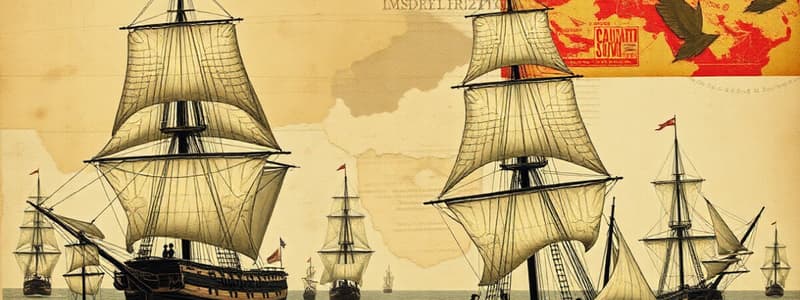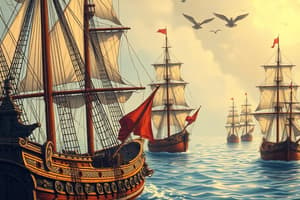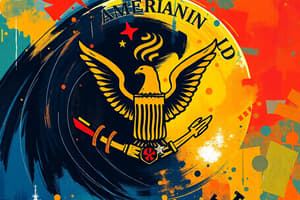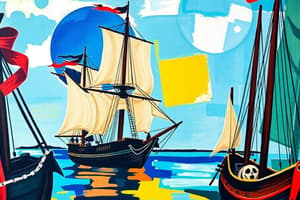Podcast
Questions and Answers
What event led to the surrender of the British ship Serapis?
What event led to the surrender of the British ship Serapis?
- The British ran out of ammunition.
- The intervention of Commodore Barry.
- A ship collision with De Grasse's fleet.
- The explosion of American grenades in the British fleet. (correct)
The battle of the Chesapeake had a definite winner.
The battle of the Chesapeake had a definite winner.
False (B)
Who is known for commanding the French fleet at the Battle of the Chesapeake?
Who is known for commanding the French fleet at the Battle of the Chesapeake?
De Grasse
James Forsten served as a _______ boy during the war.
James Forsten served as a _______ boy during the war.
Match the following individuals with their descriptions:
Match the following individuals with their descriptions:
What action did Congress take on October 13, 1775?
What action did Congress take on October 13, 1775?
The entry of the French navy into the war was a major disadvantage for the British.
The entry of the French navy into the war was a major disadvantage for the British.
What term refers to private individuals authorized to attack foreign ships during wartime?
What term refers to private individuals authorized to attack foreign ships during wartime?
The British had _____ ships when the war began.
The British had _____ ships when the war began.
What was one major advantage for the Americans in naval warfare?
What was one major advantage for the Americans in naval warfare?
Match the following naval terms with their descriptions:
Match the following naval terms with their descriptions:
Privateers only served for profit and had no impact on the war effort.
Privateers only served for profit and had no impact on the war effort.
What was the main source of funding for the privateers?
What was the main source of funding for the privateers?
What was the name of John Paul Jones' flagship?
What was the name of John Paul Jones' flagship?
John Paul Jones was named Captain on December 7, 1776.
John Paul Jones was named Captain on December 7, 1776.
What major naval victory did John Paul Jones achieve on April 24, 1778?
What major naval victory did John Paul Jones achieve on April 24, 1778?
John Paul Jones famously said, 'I have not yet begun to __________.'
John Paul Jones famously said, 'I have not yet begun to __________.'
Match the following events with their associated dates:
Match the following events with their associated dates:
Which British ship did John Paul Jones capture on September 23, 1779?
Which British ship did John Paul Jones capture on September 23, 1779?
The French entered the war in 1776 to support the Americans.
The French entered the war in 1776 to support the Americans.
Where was Machias located during the time of the events described?
Where was Machias located during the time of the events described?
Flashcards
Continental Navy
Continental Navy
The naval force created by the US Congress during the Revolutionary War.
Privateer
Privateer
A privately owned ship authorized by a government to attack enemy ships during wartime.
Letter of Marque
Letter of Marque
Official document authorizing a privateer to attack enemy ships.
British Navy
British Navy
Signup and view all the flashcards
Colonial Navy
Colonial Navy
Signup and view all the flashcards
French Navy
French Navy
Signup and view all the flashcards
Privateering Profiteering:
Privateering Profiteering:
Signup and view all the flashcards
Harassing British Shipping
Harassing British Shipping
Signup and view all the flashcards
First Naval Battle of the War
First Naval Battle of the War
Signup and view all the flashcards
John Paul Jones
John Paul Jones
Signup and view all the flashcards
Bonhomme Richard
Bonhomme Richard
Signup and view all the flashcards
1778 French Intervention
1778 French Intervention
Signup and view all the flashcards
HMS Serapis
HMS Serapis
Signup and view all the flashcards
"I have not yet begun to fight"
"I have not yet begun to fight"
Signup and view all the flashcards
Naval Victory of 1778
Naval Victory of 1778
Signup and view all the flashcards
American Naval Preparedness
American Naval Preparedness
Signup and view all the flashcards
Battle of Chesapeake
Battle of Chesapeake
Signup and view all the flashcards
French Naval Blockade
French Naval Blockade
Signup and view all the flashcards
Commodore Barry
Commodore Barry
Signup and view all the flashcards
James Forsten
James Forsten
Signup and view all the flashcards
Black Sailors in the American Navy
Black Sailors in the American Navy
Signup and view all the flashcards
Study Notes
Early American War at Sea (Comic-180)
- British had the most powerful navy globally but failed to use it effectively.
- US had a weak navy.
- Entry of the French Navy into the war was a major advantage for Americans.
- Spanish and Dutch involvement in naval battles occupied British resources.
- Continental Navy created in 1775.
- Congress authorized building warships.
- Merchant vessels converted to combat ships by 1776.
- Americans relied on privateers (legally authorized pirates)
Privateers
- Privateer is a private individual or ship authorized by government to attack foreign ships during wartime.
- Privateers were effective at harassing British shipping and redistributing captured goods.
Battle of Machias
- June 2, 1775: Local Americans seized a British schooner.
- British had 131 ships but many were poorly maintained.
- Under 40 ships were battle-ready by the end of the first year of war.
John Paul Jones
- Officially named 1st Lieutenant on December 7, 1776.
- French supplied him with 7 ships in 1778.
- Renamed his flagship the Bonhomme Richard.
- Captured the HMS Serapis on September 23, 1779.
- Famous quote: "I have not yet begun to fight."
Thanks to France
- Comte de Grasse commanded French fleet at the Battle of the Chesapeake.
- Blocked the Yorktown Peninsula, trapping the British army.
- Without supplies, British surrender was inevitable.
African Americans
- Black sailors were common in the navy.
- Recruited free and enslaved Black men.
- Recognized as courageous patriots.
- Examples like James Forsten, who became a successful businessman in Philadelphia.
Studying That Suits You
Use AI to generate personalized quizzes and flashcards to suit your learning preferences.




